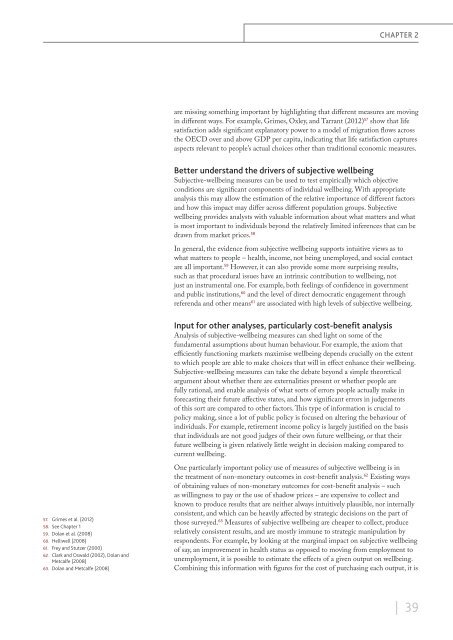commission-on-wellbeing-and-policy-report---march-2014-pdf
commission-on-wellbeing-and-policy-report---march-2014-pdf
commission-on-wellbeing-and-policy-report---march-2014-pdf
Create successful ePaper yourself
Turn your PDF publications into a flip-book with our unique Google optimized e-Paper software.
CHAPTER 2<br />
are missing something important by highlighting that different measures are moving<br />
in different ways. For example, Grimes, Oxley, <strong>and</strong> Tarrant (2012) 57 show that life<br />
satisfacti<strong>on</strong> adds significant explanatory power to a model of migrati<strong>on</strong> flows across<br />
the OECD over <strong>and</strong> above GDP per capita, indicating that life satisfacti<strong>on</strong> captures<br />
aspects relevant to people’s actual choices other than traditi<strong>on</strong>al ec<strong>on</strong>omic measures.<br />
Better underst<strong>and</strong> the drivers of subjective <strong>wellbeing</strong><br />
Subjective-<strong>wellbeing</strong> measures can be used to test empirically which objective<br />
c<strong>on</strong>diti<strong>on</strong>s are significant comp<strong>on</strong>ents of individual <strong>wellbeing</strong>. With appropriate<br />
analysis this may allow the estimati<strong>on</strong> of the relative importance of different factors<br />
<strong>and</strong> how this impact may differ across different populati<strong>on</strong> groups. Subjective<br />
<strong>wellbeing</strong> provides analysts with valuable informati<strong>on</strong> about what matters <strong>and</strong> what<br />
is most important to individuals bey<strong>on</strong>d the relatively limited inferences that can be<br />
drawn from market prices. 58<br />
In general, the evidence from subjective <strong>wellbeing</strong> supports intuitive views as to<br />
what matters to people – health, income, not being unemployed, <strong>and</strong> social c<strong>on</strong>tact<br />
are all important. 59 However, it can also provide some more surprising results,<br />
such as that procedural issues have an intrinsic c<strong>on</strong>tributi<strong>on</strong> to <strong>wellbeing</strong>, not<br />
just an instrumental <strong>on</strong>e. For example, both feelings of c<strong>on</strong>fidence in government<br />
<strong>and</strong> public instituti<strong>on</strong>s, 60 <strong>and</strong> the level of direct democratic engagement through<br />
referenda <strong>and</strong> other means 61 are associated with high levels of subjective <strong>wellbeing</strong>.<br />
Input for other analyses, particularly cost-benefit analysis<br />
Analysis of subjective-<strong>wellbeing</strong> measures can shed light <strong>on</strong> some of the<br />
fundamental assumpti<strong>on</strong>s about human behaviour. For example, the axiom that<br />
efficiently functi<strong>on</strong>ing markets maximise <strong>wellbeing</strong> depends crucially <strong>on</strong> the extent<br />
to which people are able to make choices that will in effect enhance their <strong>wellbeing</strong>.<br />
Subjective-<strong>wellbeing</strong> measures can take the debate bey<strong>on</strong>d a simple theoretical<br />
argument about whether there are externalities present or whether people are<br />
fully rati<strong>on</strong>al, <strong>and</strong> enable analysis of what sorts of errors people actually make in<br />
forecasting their future affective states, <strong>and</strong> how significant errors in judgements<br />
of this sort are compared to other factors. This type of informati<strong>on</strong> is crucial to<br />
<strong>policy</strong> making, since a lot of public <strong>policy</strong> is focused <strong>on</strong> altering the behaviour of<br />
individuals. For example, retirement income <strong>policy</strong> is largely justified <strong>on</strong> the basis<br />
that individuals are not good judges of their own future <strong>wellbeing</strong>, or that their<br />
future <strong>wellbeing</strong> is given relatively little weight in decisi<strong>on</strong> making compared to<br />
current <strong>wellbeing</strong>.<br />
57. Grimes et al. (2012)<br />
58. See Chapter 1<br />
59. Dolan et al. (2008)<br />
60. Helliwell (2008)<br />
61. Frey <strong>and</strong> Stutzer (2000)<br />
62. Clark <strong>and</strong> Oswald (2002), Dolan <strong>and</strong><br />
Metcalfe (2008)<br />
63. Dolan <strong>and</strong> Metcalfe (2008)<br />
One particularly important <strong>policy</strong> use of measures of subjective <strong>wellbeing</strong> is in<br />
the treatment of n<strong>on</strong>-m<strong>on</strong>etary outcomes in cost-benefit analysis. 62 Existing ways<br />
of obtaining values of n<strong>on</strong>-m<strong>on</strong>etary outcomes for cost-benefit analysis – such<br />
as willingness to pay or the use of shadow prices – are expensive to collect <strong>and</strong><br />
known to produce results that are neither always intuitively plausible, nor internally<br />
c<strong>on</strong>sistent, <strong>and</strong> which can be heavily affected by strategic decisi<strong>on</strong>s <strong>on</strong> the part of<br />
those surveyed. 63 Measures of subjective <strong>wellbeing</strong> are cheaper to collect, produce<br />
relatively c<strong>on</strong>sistent results, <strong>and</strong> are mostly immune to strategic manipulati<strong>on</strong> by<br />
resp<strong>on</strong>dents. For example, by looking at the marginal impact <strong>on</strong> subjective <strong>wellbeing</strong><br />
of say, an improvement in health status as opposed to moving from employment to<br />
unemployment, it is possible to estimate the effects of a given output <strong>on</strong> <strong>wellbeing</strong>.<br />
Combining this informati<strong>on</strong> with figures for the cost of purchasing each output, it is<br />
| 39



